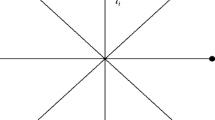Abstract
The paper offers an exploratory empirical investigation of the determinants of cooperative advertising participation rates. Using data for 2,286 brands, we examine the relationship of participation rates to national advertising expenditures by brand. We also consider how participation rates vary with average manufacturers’ margins by industry, average retail margins by category, and additional category-level variables. Reflecting the discrete nature of the dependent variable, the analysis employs discrete choice estimation techniques instead of OLS regression. The results reveal a significant quadratic relationship between advertising and participation rates. We interpret this and other significant findings in the context of existing work.
Similar content being viewed by others
References
Aaker, D.A. (1991). Managing brand equity. New York: The Free Press.
Ad Summary. January–December (1990). New York: Leading National Advertisers, Inc.
Advertising Trends Report. Spring. (1985). Peoria, IL: MultiAd, Inc.
Bergen, M., & John, G. (1997). Understanding Cooperative Advertising Participation Rates in Conventional Channels. Journal of Marketing Research, 34, 357–369.
Berger, P.D. (1972). Vertical Cooperative Advertising Ventures. Journal of Marketing Research, 9, 309–312.
Boyle, M. (2003). Brand Killers. Fortune, 148(11 August), 89–95.
Clark, S. (2000). Dual destiny. Adweek, 41, 60–66.
Collins, N.R., & Preston, L.E. (1969). Price-cost Margins and Industry Structure. Review of Economics and Statistics, 51, 271–286.
Comanor, W.S., & Wilson, T.A. (1967). Advertising, Market Structure, and Performance. Review of Economics and Statistics, 49, 423–440.
Crimmins, E. (1985). Who Should Control Co-op? Sales & Marketing Management, 134, 96–107.
Discount Store News. (1986). Co-op Reigns Where Brands Are King, 25 (3 February), 27 et seq.
Doraiswamy, K., McGuire, T.W., & Staelin, R. (1979). An Analysis of Alternative Advertising Strategies in a Competitive Franchise Framework. In N. Beckwith et al. (Eds.), Educator’s conference proceedings, American Marketing Association.
Dutta, S., Bergen, M., John, G., & Rao, A. (1995). Variations in the Contractual Terms of Cooperative Advertising Contracts: An empirical investigation. Marketing Letters, 6, 15–22.
Everett, M. (1986). Sales Tool for Synergists. Sales & Marketing Management, 136, 90–94.
Geroski, P.A. (1982). Simultaneous Equations Models of the Structure-Performance Paradigm. European Economic Review, 19, 145–158.
Hawkins, D.I., Best, R.J., & Coney, K.A. (2004). Consumer behavior. New York: McGraw-Hill/Irwin.
Heckman, J. (1979). Sample Selection Bias as a Specification Error. Econometrica, 47, 153–162.
Krishnamurthi, L., & Raj, S.P. (1988). A Model of Brand Choice and Purchase Quantity Price Sensitivities. Marketing Science, 7, 1–20.
Levitt, T. (1965). Exploit the Product Life Cycle. Harvard Business Review, 43(Nov/Dec), 81–94.
Moulton, B.R. (1990). An Illustration of a Pitfall in Estimating the Effects of Aggregate Variables on Micro Units. Review of Economics and Statistics, 72, 334–338.
Oh, M.-S., Choi, J.W., & Kim, D.-G. (2003). Bayesian inference and model selection in latent class logit models with parameter constraints: an application to market segmentation. Journal of Applied Statistics, 30, 191–204.
Porter, M.E. (1974). Consumer Behavior, Retailer Power and Market Performance in Consumer Goods Industries. Review of Economics and Statistics, 56, 419–427.
Rogers, W. (1993). Regression Standard Errors in Clustered Samples. Stata Technical Bulletin, 13, 19–23.
Round, D.K. (1983). Intertemporal Profit Margin Variability and Market Structure in Australian manufacturing. International Journal of Industrial Organization, 1, 189–209.
Somers, T.M., Gupta, Y.P., & Herriott, S.R. (1990). Analysis of Cooperative Advertising Expenditures: A transfer function approach. Journal of Advertising Research, 30, 35–49.
Steenburgh, T.J., Ainslie, A., & Engebretson, P.H. (2003). Massively Categorical Variables: Revealing the information in zip codes. Marketing Science, 22, 40–57.
Steiner, R.L. (1973). Does Advertising Lower Consumer Prices? Journal of Marketing, 37, 19–26.
Steiner, R.L. (1991). Manufacturers’ Promotional Allowances, Free Riders and Vertical Restraints. The Antitrust Bulletin, 36, 383–411.
Steiner, R.L. (1993). The Inverse Association Between the Margins of Manufacturers and Retailers. Review of Industrial Organization, 8, 717–740.
Train, K.E., & Toyama, N. (1989). Pareto Dominance through Self-Selecting Tariffs: The case of TOU Electricity Rates for Agricultural Customers. The Energy Journal, 10, 91–109.
Author information
Authors and Affiliations
Corresponding author
Rights and permissions
About this article
Cite this article
Nagler, M.G. An exploratory analysis of the determinants of cooperative advertising participation rates. Market Lett 17, 91–102 (2006). https://doi.org/10.1007/s11002-006-4387-0
Issue Date:
DOI: https://doi.org/10.1007/s11002-006-4387-0




